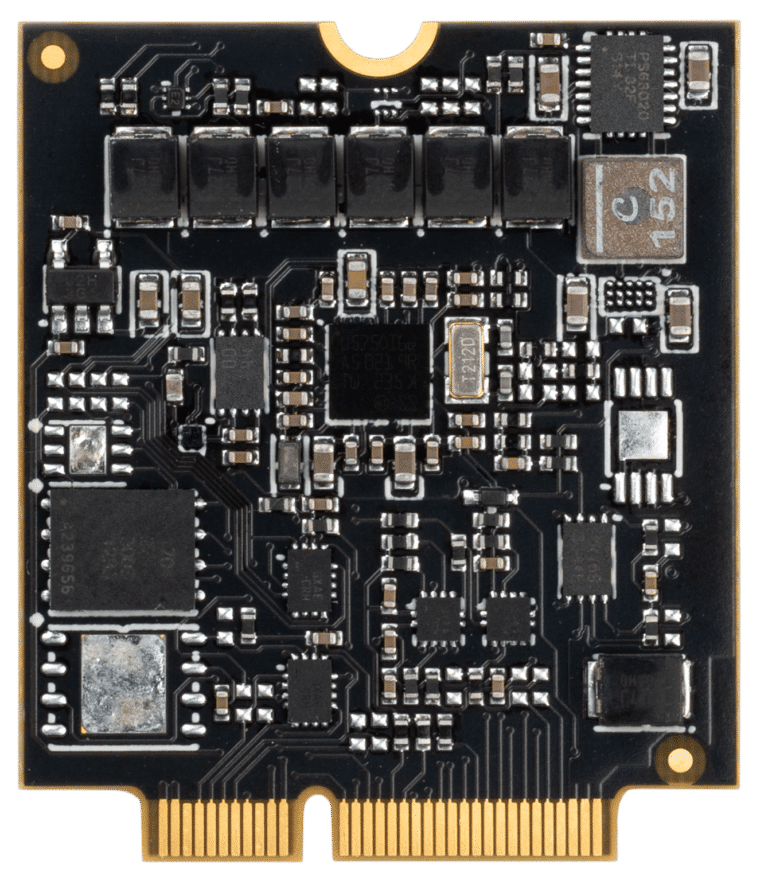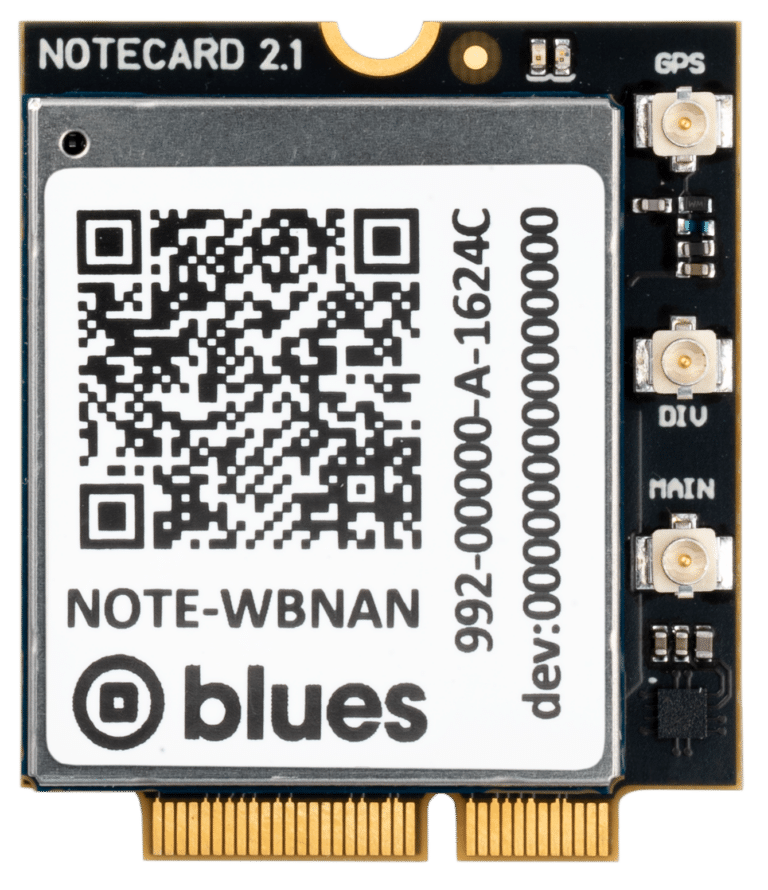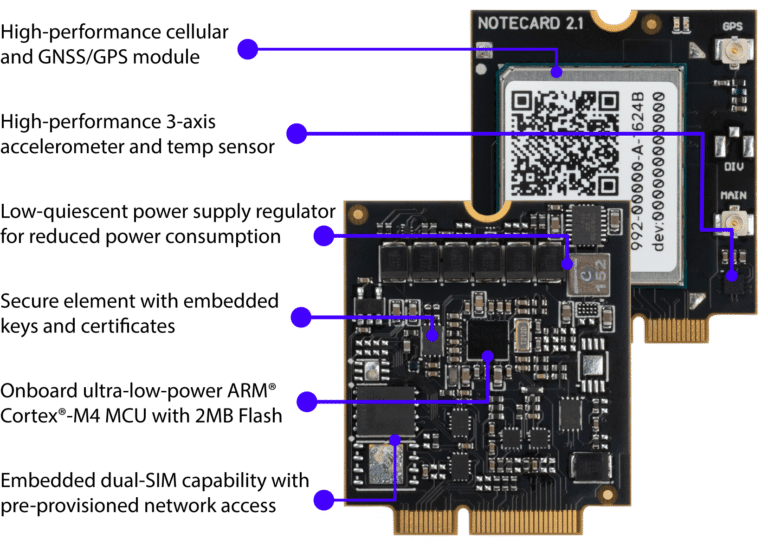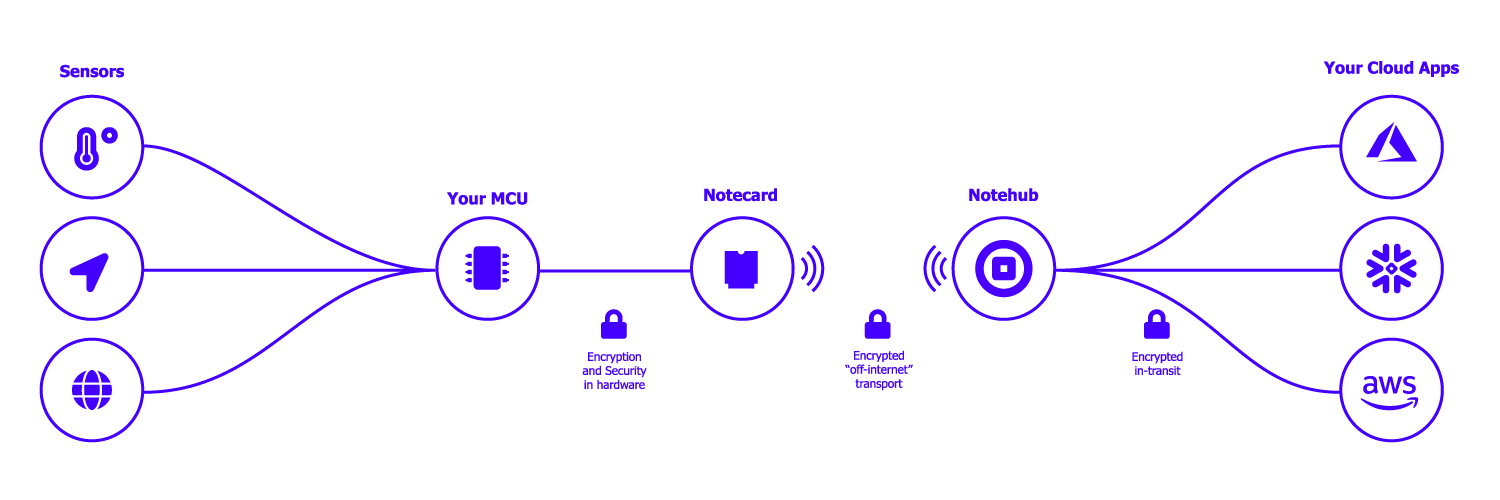-
The Notecard Cellular
Turnkey cellular connectivity packaged into a secure, low-power system-on-module
LTE Cat 1 · LTE Cat 1 bis · LTE Cat M · NB-IoT
-
We Solved Cellular Connectivity So You Can Focus on Innovating
Introducing the latest version of the Notecard Cellular.
Built with an upgraded STM32 MCU, onboard dual SIM capability, and a low-quiescent current power supply, these new Notecards deliver improved performance at a lower price.
These enhancements are integrated into a low-power system-on-module featuring secure 'off the internet' communications, pre-provisioned cloud connectivity, and GPS location for all types of fixed and mobile applications.
Along with these notable hardware improvements, we’ve added a “midband” LTE Cat 1 bis coverage option that provides wideband performance at near narrowband prices.
And, of course, each device still includes 500MB of prepaid cellular connectivity.

Your Gateway to Intelligent Connected Products
A Suite of Coverage Options
The Notecard Cellular includes 500MB of cellular data and offers versatile coverage options, including NB-IoT, Cat-M, LTE Cat 1 bis, and LTE Cat-1 with North American, EMEA, and Global coverage models.
Harmonized Wireless Architecture
Switch between any of the 4 major RATs (Cellular, Wi-Fi, LoRa, and Satellite) at any point in the product development cycle with our interchangeable architecture.
Pinpoint Multi-Source Asset Tracking
Dynamically track all your assets with our “best location” feature that aggregates location data from various sources like cell towers, Wi-Fi access points, and GPS/GNSS.
Fast-Track Your Time to Market
Blues’ pre-provisioned connectivity and low-code JSON interface reduce your time to market from years to months.
Effortless Data Routing to any Cloud
Route data to any cloud, including AWS, Azure, GCP, Snowflake, and more, using Notehub — often in a “no code” implementation.
Industry-Leading Security
End-to-end security from devices authenticated through an integrated secure element to dataflows using encrypted communications and VPN tunnels.

-
Coverage Tailored to Your Solution
The latest Notecard Cellular version introduces a “midband” LTE Cat 1 bis Notecard alongside LTE Cat 1, LTE Cat M, and NB-IoT options. Each option is offered in North American and Global coverage models, enabling you to customize your coverage to your deployment further.
LTE Cat 1 bis functions seamlessly within established LTE networks and distinguishes itself by operating efficiently with a single antenna, contrasting with the two antennas required to support LTE Cat 1. This innovation reduces unit cost while making them more compact and more accessible to design.
An Integrated, Low-Power Cellular Data Pump

How it Works
Build
Add the Notecard to your product with your preferred hardware.
Integrate
Configure all Notecards with the same plug-and-play hardware and firmware interface.
Configure
With Notehub, enjoy secure bi-directional data flow between your device and your cloud app.

Transform Products into Data-Driven Services with Blues
To succeed today and get ahead of tomorrow, businesses need to transform into data-driven “as a service” providers by capturing their product’s data and routing it to the cloud, which can be packaged into valuable service offerings.
Here are just a few of the benefits of developing a connected product:
Create new recurring revenue streams by transforming your product’s data into valuable service offerings.
Attract and retain customers by arming them with cutting-edge tools to enhance operational efficiency.
Gain insight into your product to improve performance and drive innovation.
Capture untapped data points for more informed decision-making.
Hear Why Our Customers and Partners Build with Blues
I like working with Blues because it solves several very important problems for me that I no longer have to worry about.
Danny Wilson
Founder & CEO of Geocene
By using the Blues platform, we saved about 12 months of R&D time, getting us to market about a year sooner.
Jamie Fox
Director, Technology & CRM at Tekion